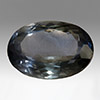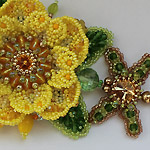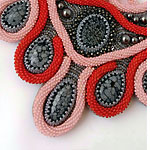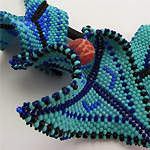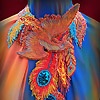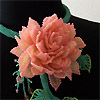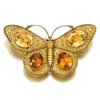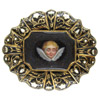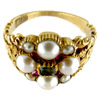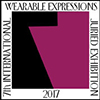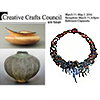April, 2016

From MyLovelyBeads.com with LoveSpringtime! Poet Sherine Shah wrote, "When spring comes around, butterflies flutter their wings - In happiness of fresh flowers saying, 'Yes! It's spring.'" Read in the April's issue:
Sillimanite - state mineral of Delaware
Contact us with any questions at
info@mylovelybeads.com.
Fashion Colorworks 2016. First entries In Prague creativity is in full swing Georgian period jewelry Wearable Expressions 2017 Upcoming events Best regards,
MyLovelyBeads.com Team |
|
Dear friends! The son of our friends suffers severe hearing loss. The child could not hear the World from his birth; such a rare disease can be cured only in the United States. Parents stood in line at the Rosfond on the allocation of funds for the surgery, but the issue of funds decreased in 2016. Part of the money is already collected and the part will be allocated by Rosfond, but the money is still not enough. Here Peter's mother is telling his story (in Russian). Let's not remain indifferent and help the boy hear the World!
RUB Account Visa Sberbank 4173 9800 4431 9982
Contacts: |
||||||||
Sillimanite - state mineral of DelawareSillimanite is a rare, transparent to opaque gemstone that occurs in colorless, grayish-white, yellow-green, bluish and brownish hues. The luster of sillimanite is vitreous to silky. Sillimanite belongs to the same group of minerals as andalusite and kyanite: they share a similar chemical composition, but have differing crystal structures. Sillimanite is the rarest of them. Sillimanite is named after the American chemist Benjamin Silliman (1779-1864), the founder of the American Journal of Science. It was first described in 1824 for an occurrence in Chester, Middlesex County, Connecticut, USA. Sillimanite is usually formed at high temperatures and is known to be a useful heat-resistant and chemical corrosion resistant material that is used in iron and steel smelting, and the cement, ceramics and glass industries. The hardness of sillimanite along with its resistance to heat means that it has good durability. However, due to its rarity, sillimanite is not often seen in jewelry. Sometimes, faceted sillimanite is dyed to imitate precious gemstones such as rubies and emeralds. Sillimanite gems may appear similar to a variety of other stones, such as beryl and moonstone. Like diamond and topaz, sillimanite has perfect cleavage, which means that care should be taken when setting and wearing sillimanite, since a hard blow could cause it to split. A common variety of sillimanite is known as FIBROLITE, so named because the mineral appears like a bunch of fibres twisted together when viewed in thin section or even by the naked eye. When the fibers of sillimanite are chatoyant and aligned in a certain way, they exhibit a strong and sharp cat's eye effect, which makes it valuable among collectors cut as cabochons rather than faceted gemstones... |
||||||||
Fashion Colorworks 2016. First entries
The contest continues and more than a month to go. You can submit your entries for the Fashion Colorworks 2016 Beading Contest in three categories up to June 10. We are looking forward to seeing your amazing bead items in the contest!
Fashion Colorworks 2016 Rules
|
||||||||
In Prague creativity is in full swingLiving in the heart of Europe, in the city of Prague, the Czech Republic capital, Anna Mochrov (over the Internet she's known as Anna Master) find Prague an amazing place where her creative work is in full swing. Anna mostly makes beadwoven jewelry inspired by nature, and her bead flower compositions attract many bead lovers. She is also known as a teacher created a number of tutorials beading. Meet Anna, enjoy her story and the pictures of her jewelry! Anna says, "It was long time ago, in 2007 my husband and I moved to Cyprus. Very soon we realized that it was a little boring island and life there was not interesting. For this reason, in the evenings I spent a lot of time on the Internet and somehow accidentally saw a beautiful beaded piece jewelry. Further searches led me to believe that I also want to try to do something similar. My first inspirers were Huib Petersen, Karen Paust, Zoya Gutina and Guzel Bakeeva - they all have created jewelry that could ignite you! Having bought the first one, then a small "portion" of beads (that process, by the way, in Cyprus was not easy because of the almost complete absence of craft shops), I began to "reinvent the wheel". Looking for classes and tutorials, and so on is not my style, because to invent something is much more interesting to me than doing according somebody's tips. Looking at pictures of beadworks, I adopted "engineering way of thinking" and took patience, and began to speculate logically on how the items on the photo could be made. As a result, my way into bead world turned out to be longer than many others' who did not make "discoveries" in the field of peyote and herringbone stiches and other basic techniques, but just learned beading using tutorials. I had only pictures of finished works found on the Internet as the examples, so I "played" with beads on the principle of "what will happen if I do this?" Something was made pretty well, something was altered, and something was ripped. That time I've worked in a large company at the very nervous position and came home from work morally squeezed. Beadwork became my outlet, my wonderland, where fascinating discoveries waited for me every day, favorite heroes lived and feats were committed. Moving from simple to complex, by trial and error, I was more and more fascinated by beaded flowers - not made using French technique (on the wire), but woven. Looking at the photos of live flowers, I thought about how this fragile beauty could be create in beads and invented all sorts of fancy flowers, which then I began to put into floral arrangements. Since I've been a self-taught beader and have never been interested in anybody's tutorials, I didn't think whether there was something like that; the thought to create instructions didn't come to my mind..."
Full article by Anna Mochrov (Anna Master)
|
||||||||
Georgian period jewelryThe Georgian period, from 1714 to 1837, was named and defined by four Georges; George I (r. 1714-1727), George II (r. 1727-1760), George III (r. 1760-1820), and George IV (r. 1820-1830) along with William IV (r. 1830-1837). This period, which spanned most of the XVIII Century and a part of the XIX, was marked by significant changes when the entire globe was transformed. It was a time of the decorative aesthetics of Rococo (late Baroque), Neoclassicism and Romanticism; the American and French Revolutions; George Washington, Napoleon Bonaparte and Catherine the Great. All of this combined with great achievements in science and world exploration, and changes in society created the perfect backdrop for the creation of the magnificent Georgian jewelry. Prior to the mid-1700's attempts were made to setup by laws what items of clothing and jewelry could be worn based on rank or income. These sumptuary laws were often ignored and during the Georgian era they largely disappeared. Jewelry styles came to be designated as to the time of day they should be worn. During the daylight hours women wore a necklace or chain with a watch, a cameo or lace pin, small colored stone rings, matching bracelets and earrings of any length. Gentlemen could not be seen anywhere without a fabulous pair of status establishing shoe buckles and buttons made from any material and studded with diamonds, paste and gemstones. Garnet, topaz, emerald and ruby were popular, and materials from nature were abundant in daytime jewelry. Coral, amber, ivory, pearls along with turquoise, translucent agates and carnelian were used in a variety of ways. Strands of beads, riviere necklaces, parures, cameos and intaglios all featured these natural gems. Right alongside, and almost equally as popular, were the imitations; paste, faux pearls, opaline glass, Vauxhall glass, etc. Iron and cut steel, pinchbeck (alloy of copper and zinc to substitute gold), silver and gold were all utilized as materials for Georgian jewelry; timeless long chains were a signature of the period... |
||||||||
Wearable Expressions 2017
January 21 - April 16, 2017 Long time waited, the 7th International Juried Exhibition of Wearable Art "Wearable Expressions 2017" will take place in the Palos Verdes Art Center in Los Angeles area. The goal of the exhibition is featuring wearable art designed for the human body in all media, including jewelry and accessories:
• to promote the fine art aspect
of wearable art media in an international
forum;
• to encourage the creation of innovative art to wear; • to share vision and exploration of techniques and materials. This exhibition is open to adults 18 years or older. The use of innovative materials and techniques is encouraged. The categories are textiles, jewelry and accessories. Along with traditional fabrics, there have been garments created from pinecones, blown glass, metal, paper, electronics, etc. Each artist can submit up to three items for consideration in any or all of the above categories. The entry deadline is October 1, 2016; the exhibition winners will receive prizes of $20,000. |
||||||||
Upcoming eventsCreative Crafts Council: On Tour
March 11 - May 21, 2016 The Baltimore Clayworks hosts Creative Crafts Council: On Tour. This exhibition features artists whose work had received awards at the Creative Crafts Council 30th Biennial Exhibition, which originally took place at Strathmore Mansion in June-July 2015. |
||||||||
Note
If you don't see the newsletter properly formatted please click here:
April Issue
|
||||||||
© 2016 MyLovelyBeads.com All Rights Reserved.
If you do not want receive our newsletter and you wish to remove your email address from our mailing list, please click the following link to unsubscribe.




